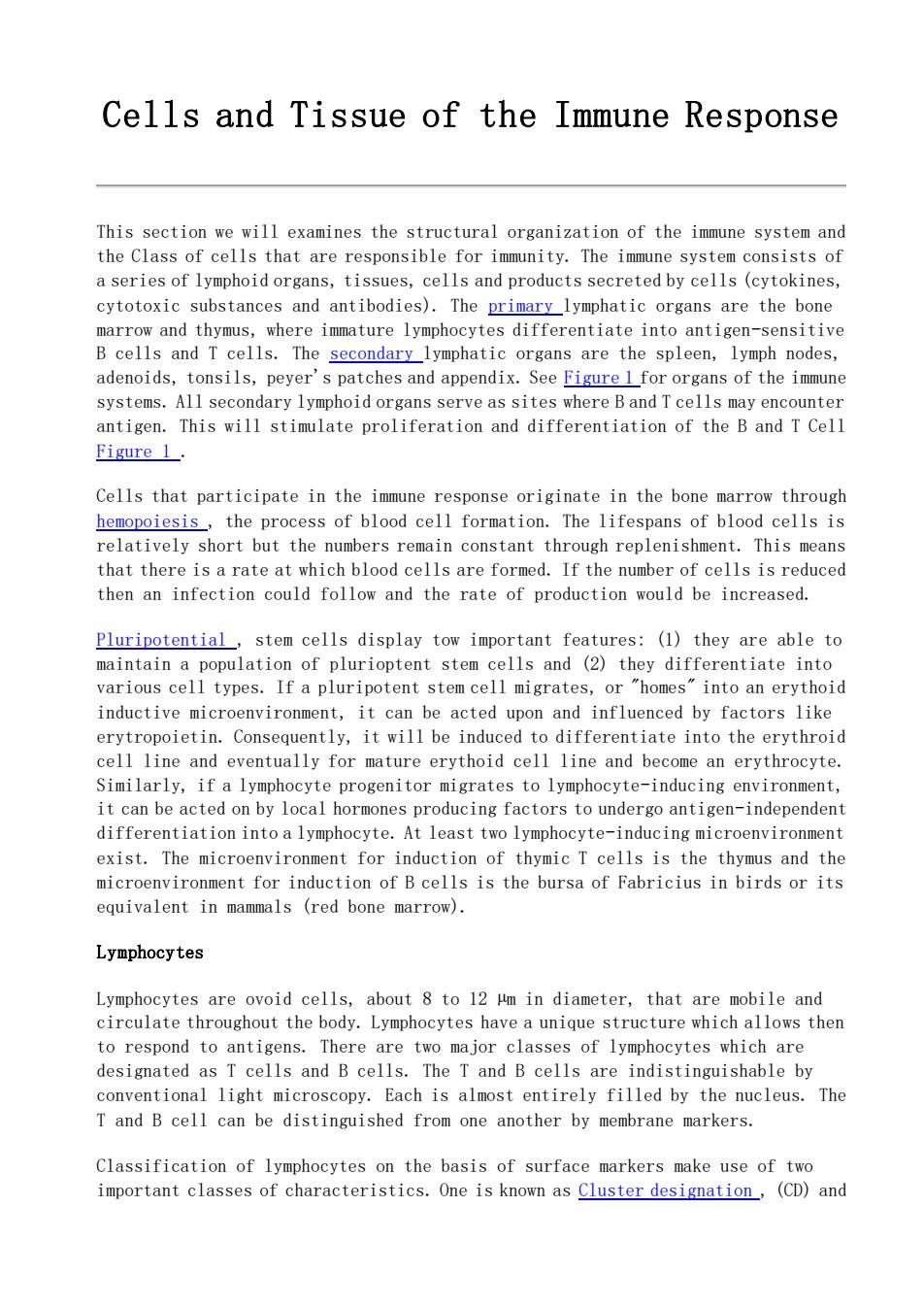正在加载图片...

Cells and Tissue of the Immune Response This section we will examines the structural organization of the immune system and the Class of cells that are responsible for immunity.The immune system consists of a series of lymphoid organs,tissues,cells and products secreted by cells(cytokines, cytotoxic substances and antibodies).The primarylymphatic organs are the bone marrow and thymus, where immature lymphocytes differentiate into antigen-sensitive B cells and T cells.The secondary_lymphatic organs are the spleen,lymph nodes, adenoids,tonsils,peyer's patches and appendix.See Figure 1for organs of the immune systems.All secondary lymphoid organs serve as sites where B and T cells may encounter antigen.This will stimulate proliferation and differentiation of the B and T Cell Figure 1. Cells that participate in the immune response originate in the bone marrow through hemopoiesis.the process of blood cell formation.The lifespans of blood cells is relatively short but the numbers remain constant through replenishment.This means that there is a rate at which blood cells are formed.If the number of cells is reduced then an infection could follow and the rate of production would be increased. Pluripotential stem cells display tow important features:(1)they are able to maintain a population of plurioptent stem cells and (2)they differentiate into various cell types.If a pluripotent stem cell migrates,or "homes"into an erythoid inductive microenvironment,it can be acted upon and influenced by factors like erytropoietin.Consequently,it will be induced to differentiate into the erythroid cell line and eventually for mature erythoid cell line and be come an erythrocyte Similarly,if a lymphocyte progenitor migrates to lymphocyte-inducing environment it can be acted on by local hormones producing factors to undergo antigen-independent differentiation into a lymphocyte.At least two lymphocyte-inducing microenvironment exist.The microenvironment for induction of thymic t cells is the thymus and the ment for induction of B cells is the bursa of Fabricius in birds or its Lymphocytes Lymphocytes are ovoid cells,about 8 to 12 um in diameter,that are mobile and circulate throughout the body.Lymphocytes have a unique structure which allows then to respond to antigens.There are two major classes of lymphocytes which are designated as T cells and B cells.The Ta and B cells are guishable by conventional light microscopy.Each is almost entirely filled by the nucleus.The T and B cell can be distinguished from one another by membrane markers. Classification of lymphocytes on the basis of surface markers make use of two important classes of characteristics.One is known as cluster designation.(CD)and Cells and Tissue of the Immune Response This section we will examines the structural organization of the immune system and the Class of cells that are responsible for immunity. The immune system consists of a series of lymphoid organs, tissues, cells and products secreted by cells (cytokines, cytotoxic substances and antibodies). The primary lymphatic organs are the bone marrow and thymus, where immature lymphocytes differentiate into antigen-sensitive B cells and T cells. The secondary lymphatic organs are the spleen, lymph nodes, adenoids, tonsils, peyer's patches and appendix. See Figure 1 for organs of the immune systems. All secondary lymphoid organs serve as sites where B and T cells may encounter antigen. This will stimulate proliferation and differentiation of the B and T Cell Figure 1 . Cells that participate in the immune response originate in the bone marrow through hemopoiesis , the process of blood cell formation. The lifespans of blood cells is relatively short but the numbers remain constant through replenishment. This means that there is a rate at which blood cells are formed. If the number of cells is reduced then an infection could follow and the rate of production would be increased. Pluripotential , stem cells display tow important features: (1) they are able to maintain a population of plurioptent stem cells and (2) they differentiate into various cell types. If a pluripotent stem cell migrates, or "homes" into an erythoid inductive microenvironment, it can be acted upon and influenced by factors like erytropoietin. Consequently, it will be induced to differentiate into the erythroid cell line and eventually for mature erythoid cell line and become an erythrocyte. Similarly, if a lymphocyte progenitor migrates to lymphocyte-inducing environment, it can be acted on by local hormones producing factors to undergo antigen-independent differentiation into a lymphocyte. At least two lymphocyte-inducing microenvironment exist. The microenvironment for induction of thymic T cells is the thymus and the microenvironment for induction of B cells is the bursa of Fabricius in birds or its equivalent in mammals (red bone marrow). Lymphocytes Lymphocytes are ovoid cells, about 8 to 12 µm in diameter, that are mobile and circulate throughout the body. Lymphocytes have a unique structure which allows then to respond to antigens. There are two major classes of lymphocytes which are designated as T cells and B cells. The T and B cells are indistinguishable by conventional light microscopy. Each is almost entirely filled by the nucleus. The T and B cell can be distinguished from one another by membrane markers. Classification of lymphocytes on the basis of surface markers make use of two important classes of characteristics. One is known as Cluster designation , (CD) and